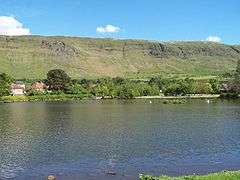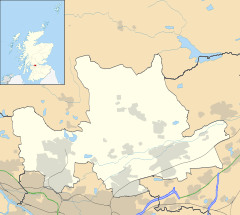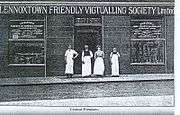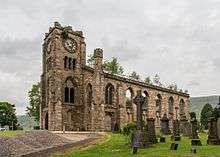Lennoxtown
Lennoxtown (Scottish Gaelic: Baile na Leamhnachd, pronounced [ˈpalə nə ˈʎãũnəxk]) is a town in East Dunbartonshire, Scotland at the foot of the Campsie Fells, which are just to the north.
Lennoxtown
| |
|---|---|
 Lennoxtown Dam, with the Campsie Fells behind | |
 Lennoxtown Location within East Dunbartonshire | |
| Population | 4,094 |
| OS grid reference | NS625775 |
| Council area | |
| Lieutenancy area | |
| Country | Scotland |
| Sovereign state | United Kingdom |
| Post town | GLASGOW[1] |
| Postcode district | G65 G66 |
| Dialling code | 01360 |
| Police | Scotland |
| Fire | Scottish |
| Ambulance | Scottish |
| UK Parliament | |
| Scottish Parliament | |
It is now part of the East Dunbartonshire council area but prior to 1975 was in the historic county of Stirlingshire.
It had a population of 4,094 at the 2011 UK Census.
History



The focus of the Lennoxtown area used to be the busy Lennox Mill, where tenants of the Woodhead estate brought their corn to be ground. There were several corn mills in Campsie Parish, but this was arguably the most important. Lennox Mill was located in the vicinity of the recently demolished Kali Nail Works.
A significant event in the history of the locality was the establishment of the calico printing works at Lennoxmill during the late 1780s, on a site adjacent to the old corn mill. Calico is a type of cotton cloth, and the printing of cotton cloth was soon established as a major industry in the area, also at Milton of Campsie. It was to provide accommodation for the block makers and other cotton printing workers that the village of Lennoxtown was established, during the late eighteenth and early nineteenth centuries. Streets of houses were planned and built according to a formal plan. Lennoxtown was at first known as 'Newtown of Campsie',[2] to distinguish it from the 'Kirktoun' or 'Clachan' of Campsie, at the foot of Campsie Glen.
During the 19th century Lennoxtown grew to be the largest centre of population in Campsie Parish. Another important industry was soon established – a chemical works, founded by Charles Macintosh (of waterproof clothing fame) and his associates. At first their principal product was alum, a chemical employed in the textile industry. Alumschist, the basic ingredient in the process, was mined in the area. The works came to be known as the Secret Works, presumably because of the need to keep the industrial processes secret.
During the 1790s many of the Lennoxmill workers supported the political reformer Thomas Muir of Huntershill in his campaigns to establish democracy in Scotland, and a Reform Society was set up in Campsie in 1792. However, the parish minister, the Rev. James Lapslie, saw to it that there was also some opposition to Muir's ideas in the area. An important milestone in the drive towards democracy was the establishment in 1812 of a local co-operative society, the Lennoxtown Friendly Victualling Society, one of the earliest of its kind in Scotland.
The growing importance of Lennoxtown was underlined by the removal of the parish church from the Clachan to the New Town during the 1820s. Plans for the new church were prepared by the architect David Hamilton, who was also responsible for the nearby Lennox Castle.[3] A Roman Catholic church was erected in 1846 (originally St Paul's, later renamed St Machan's), one of the earliest post-Reformation Catholic churches in Scotland, apart from those in cities and large towns.
The decline of the industries that flourished during the nineteenth century, and also the later nail-making industry (and indeed the famous Victualling Society) has left Lennoxtown in a kind of post-industrial limbo, from which it has been difficult to escape. Slow progress continues to be made.
The town was well known in Scottish football circles as the home of Campsie Black Watch FC, an under-21 club founded in 1943 which launched the careers of many professional players[4] (Willie Garner, Eddie Gallagher, Johnny Walker, Frank Haffey, Mike Larnach, Jim Thomson), also winning the Scottish Juvenile Cup 11 times between 1955 and 2014 before eventually folding in 2017,[5] a short time before the death of long-serving president Gerry Marley.[6]
Primary schools
St Machan's
St Machan's Primary School was opened in 1964, replacing a smaller school on Bencloich Road. The old building was then used as the Campsie Recreation Centre, until demolition in 2009. In 2009, St Machan's had 200 pupils. It is a feeder school for St Ninian's High School in Kirkintilloch.[7] In 2009, St Machan's had 200 pupils enrolled in the school and would later move on to St Ninian's High School which enrolled 757 pupils in 2009. In 2013, there was a petition in order to get a skate park to replace the old recreation centre and was handed out in the local businesses to get members of the local community to sign.
Lennoxtown Primary School
In 1839 the Lennoxtown New Subscription School was given a grant of £280,000 from the government in order to rebuild. The school was made up of two large buildings and opened in 1840. It had a room for over one hundred primary age pupils and a second room for infant pupils. A new school was built in 1896 and expanded to seven classrooms for 458 pupils. The Lennoxtown Public School was reduced to the status of Lennoxtown Primary School in 1963, with secondary pupils instead attending Kilsyth Academy. Lennoxtown Primary enrolled 128 pupils in 2009.[7]
The Community Hub
A Community Hub is set to be built on the Main Street as a focus for the delivery of public services. It will bring together the existing East Dunbartonshire Library, the NHS Clinic, which will contain a dental practice and GP consulting rooms. and the Housing office[8] in one building. Completion is due in November 2014.[9] One of the oldest surviving branches of the Co-operative is to be demolished as part of the development. An attempt to have the building listed was unsuccessful.[10]
Lennoxtown Railway
The railway to Lennoxtown was an extension of the Glasgow to Edinburgh line. The first 5 1⁄2 miles (9 kilometres) of this line, from Lenzie to Lennoxtown, were built by the Edinburgh and Glasgow railway, under powers obtained in 1845 and it was officially opened on 5 July 1848. The railway was initially intended to serve the print fields at Lennoxtown but it eventually allowed passengers and provided this service as far as Aberfoyle. The passenger service was discontinued in October 1951, the transportation of goods continuing but only as far as Lennoxtown from 1959. The line closed completely in 1966.[11] Lennoxtown Station won first prize for being the best kept railway station in Scotland in 1897 and then for 7 years in succession from 1922 to 1928 and again in 1930 and 1931.
Lennoxtown Training Centre

It was announced that Celtic training ground was going to be built in Lennoxtown' in 2005[12] by the then manager Gordon Strachan. The 20-hectare (50-acre) training ground was built on the grounds of Lennox castle and was officially opened in October 2007. The facility has three natural grass, UEFA match-size pitches and one full-size, all weather, artificial pitch which is floodlit. There is undersoil heating, a state-of-the-art gym, a sauna and steam room and changing facilities.[13]
Local football teams, such as the Campsie Boys' Club, train there once a week. Celtic liaise with the local schools (St. Machan's and Lennoxtown Primary School) to allow occasional use of their training facilities. There are educational facilities for the young Celtic Academy footballers at the ground and arrangements for them to attend St.Ninian's High School in Kirkintilloch. The school football team use the training ground facilities. Stuart Findlay was part of the initial intake of this scheme in 2009[14] before leaving Celtic and establishing himself as a professional with Kilmarnock.
Town hall
In the 1860s a town hall at Lennoxtown was built, now called the Campsie Memorial Hall; construction began in 1866 and was funded by subscription. Two years later, the hall was opened. Altogether, it cost £1,340.[15] In the 1950s the District Council took over the hall in order for the building to be renovated.[16]
The threat of the Campsie Memorial Hall being shut down in 2010 due to lack of funding, made the residents of Lennoxtown come together to offer up their own solutions. More than 150 people attended a public meeting to talk over plans for the hall and around 35 residents signed up to be on the committee for managing the town hall[17] The hall itself was taken over by volunteers from Lennoxtown in late 2012 and has been thriving since. In 2013, they were given a grant from the EDC Civic Pride Fund and received funding from the Big Lottery, which were both used to improve the hall.
Notable people connected with Lennoxtown
- Tam Baillie, Scotland's Commissioner for Children and Young People between 2009–2017.
- Robert Dalglish, Provost of Glasgow, merchant and calico printer.
- Alex Ferns, actor, born 13 October 1968.
- Lulu, singer (real name Marie McDonald McLaughlin Lawrie), born Lennox Castle Hospital, 3 November 1948.
- Drew McAdam, mentalist and mindreader, born Lennoxtown, 4 June 1955.
- Sir Ian McCartney, Former Government Minister and Chair of the Labour Party, born 25 April 1951.
- Jim McGinlay, Bass guitar player with bands Salvation and Slik, born Lennox Castle Hospital, 9 March 1949
- Thomas McGraw, gangster and criminal.
- Owen 'Onnie' McIntyre, musician with Average White Band, born Lennox Castle Hospital, 25 September 1949
- Ted McKenna, drummer with The Sensational Alex Harvey Band, born 10 March 1950.
- John McLane, Governor of New Hampshire (1905–07).
- Kirsty Milne, broadcaster and journalist.
- Bishop Ian Murray (1932-2016), Roman Catholic Bishop Emeritus of the Diocese of Argyll and the Isles, Scotland.
- Billy Rankin, musician and broadcaster, born Lennox Castle Hospital, 25 April 1959.
Footballers
- Jack Britton, born 1900
- John Brown, born 1962
- John Hendrie, born 1963
- John Johnston, born 1878
- Denis Lawson, born 1897
- Alan Mackin, born 1955
- John McLaughlin, born 1936
- Bill Millar, born 1950 (played for Canada)
- Sandy Pate, born 1944
- Ricky Sbragia, born 1956
References
- Evox Facilities. "List of UK post towns". Evox Facilities. Archived from the original on 19 February 2012. Retrieved 22 February 2012.
- "Overview of Lennoxtown". Gazetteer for Scotland. Retrieved 6 May 2012.
- "Overview of Lennox Castle". Gazetteer for Scotland. Retrieved 6 May 2012.
- Campsie heroes facing a black future 61 years of history threatened, The Herald, 30 October 2004
- Campsie Black Watch fold after 74 years at the top, Youth Football Scotland, 27 June 2017
- Campsie Black Watch boss Gerry Marley passes away, Kirkintilloch Herald, 20 December 2018
- "Lennoxtown Community Hub | anderson bell & christie". Andersonbellchristie.com. Retrieved 17 November 2013.
- "Survey on community hub in Lennoxtown". s1Lennoxtown. Archived from the original on 3 December 2013. Retrieved 17 November 2013.
- Hepburn, David (1 October 2013). "Lennoxtown building which contained historical co-operative society to be bulldozed". Kirkintilloch Herald. Retrieved 17 November 2013.
- "Railway". Welcometolennoxtown.co.uk. Retrieved 25 November 2013.
- "Lennoxtown". The Celtic Wiki. Retrieved 17 November 2013.
- "Celtic Unveil World Class Training Center - The Offside - Celtic blog". Celtic.theoffside.com. Archived from the original on 12 October 2007. Retrieved 17 November 2013.
- Custom byline text: (4 June 2012). "Stuart Findlay: Celtic youth player and one of original intake in 2009". Herald Scotland. Retrieved 17 November 2013.CS1 maint: extra punctuation (link)
- "Town Hall". Welcome to Lennoxtown. Retrieved 8 February 2014.
- "Town Hall". Welcometolennoxtown.co.uk. Retrieved 25 November 2013.
- "Hall to play for in Lennoxtown". Kirkintilloch Herald. 18 May 2010. Retrieved 25 November 2013.
- "About Lennoxtown". Welcometolennoxtown.co.uk. Retrieved 5 October 2015.
- "Past History - Lennoxtown Landscapes". Lennoxtownlandscapes.webs.com. Archived from the original on 25 May 2014. Retrieved 5 October 2015.
- "Archived copy". Archived from the original on 16 October 2016. Retrieved 11 November 2015.CS1 maint: archived copy as title (link)